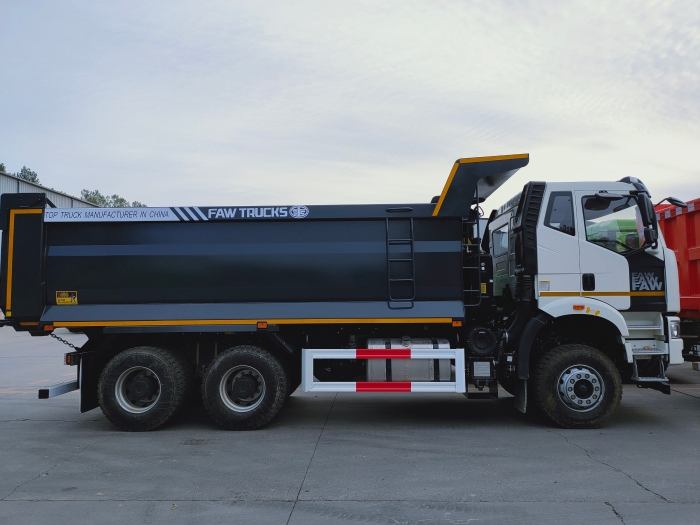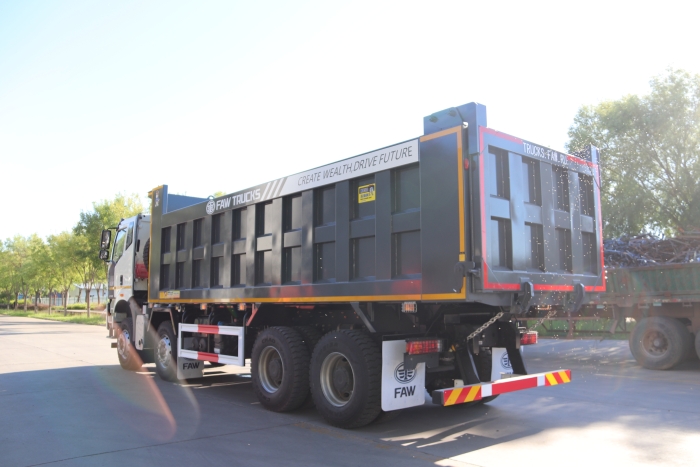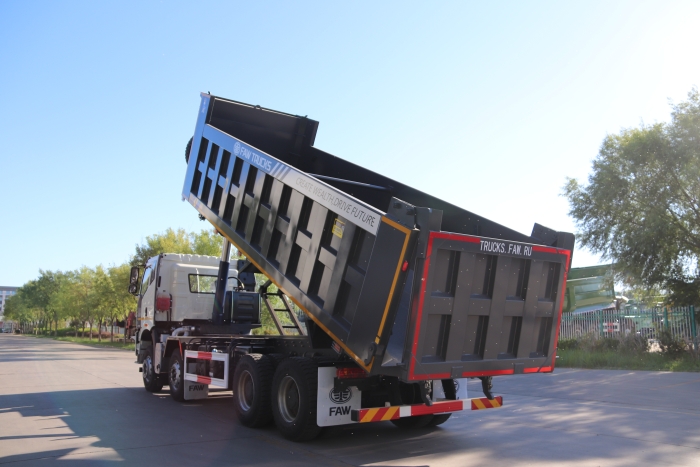- PRODUCTS
- SOLUTION
- SERVICE
- NEWS
- ABOUT US
A 3-axle semi-trailer has three axles designed to support heavy loads and ensure stability.
The semi-trailer's primary structure includes the chassis frame, wheels, and the coupling device. The chassis frame, made of high-strength steel, supports the cargo load and withstands the stresses of the road. The wheels, typically situated at the rear end of the trailer, provide the necessary mobility. The coupling device, known as the fifth wheel, attaches the semi-trailer to the tractor.
The working principle of a semi-trailer revolves around its ability to distribute the cargo weight between the tractor and its own wheels. This design reduces the load on each axle, enhancing road safety and increasing the potential cargo capacity.

Axles are central shafts for rotating wheels or gears. In semi-trailers, axles are crucial for supporting the trailer's weight and facilitating motion. They bear the brunt of the load and are key to ensuring the vehicle's stability and maneuverability.
· Two-Axle Semi-Trailers: Generally used for lighter loads. They offer better maneuverability but have a lower load-bearing capacity.
· Three-Axle Semi-Trailers: Designed for heavier loads, these trailers provide improved stability and distribution of weight, which is crucial for transporting heavy or oversized cargo.
For further details on the specific roles and regulations of semi-trailer axles, as well as maintenance and safety aspects, please explore the subsequent sections.
Three-axle semi-trailers feature a robust design, primarily built to handle significant loads. The three axles, strategically placed, provide a sturdy base for the trailer, ensuring stability and efficient weight distribution.
· Frame: Made from high-tensile steel, offering strength and durability.
· Axles: Three in number, usually equipped with advanced suspension systems to enhance load capacity and road safety.
· Braking System: Often includes ABS (Anti-lock Braking System) for improved safety.
· Wheels: Larger in number, providing better support and reducing the pressure on road surfaces.
· Load Capacity: Three axles offer a higher load capacity compared to two-axle trailers, crucial for heavy or bulky cargo.
· Stability: Enhanced stability, especially at high speeds or in challenging driving conditions.
· Legal Compliance: Meets a variety of road and safety regulations for heavy loads.

· Enhanced Safety: Stability and braking efficiency reduce the risk of accidents.
· Higher Load Capacity: Can transport heavier loads, increasing operational efficiency.
· Versatility: Suitable for a wide range of cargo types, from heavy machinery to bulk commodities.
· Initial Cost: Generally more expensive than two-axle trailers due to additional materials and technology.
· Maintenance: Requires more maintenance, especially in the axle and suspension systems.
· Maneuverability: Less maneuverable in tight spaces compared to two-axle trailers.
Axles play a pivotal role in the overall performance of semi-trailers. They are key in determining the trailer's stability, load capacity, and road safety.
· Stability: Axles, especially in three-axle trailers, distribute the weight evenly. This distribution is crucial for maintaining balance, particularly when navigating turns or uneven road surfaces.
· Load Capacity: The number of axles directly impacts the maximum load the trailer can legally and safely carry. More axles typically mean higher load capacity.
· Road Safety: Axles contribute to the braking efficiency of the trailer. Properly maintained axles ensure a safer driving experience, reducing the risk of accidents.
Different regions have specific regulations regarding axle numbers and weight limits. These regulations aim to protect road infrastructure and ensure safety.
· Weight Limits: Imposed to prevent road damage and ensure safety. Exceeding these limits can lead to legal penalties and increased wear on the trailer.
· Axle Spacing: Regulated to optimize weight distribution and road safety.
Aspect | Description | Impact |
Weight Limit | Maximum weight per axle, varies by region. | Determines load capacity. |
Axle Number | Regulations may require a certain number of axles. | Affects the type of cargo hauled. |
Axle Spacing | Specific spacing requirements for axles. | Influences weight distribution. |
Regular maintenance of axles is crucial for the safe and efficient operation of semi-trailers.
· Inspection: Regular checks for wear and tear, especially in bearings and joints.
· Lubrication: Essential for the smooth operation of axle components.
· Repairs: Prompt addressing of any issues to prevent accidents and breakdowns.
· Wear and Tear: Regular use can lead to wear. Solution: Routine inspections and timely replacements.
· Alignment Problems: Can cause uneven tire wear and reduce fuel efficiency. Solution: Regular alignment checks.
· Brake Issues: Axle-related brake failures can be hazardous. Solution: Regular brake system checks and maintenance.
By understanding the importance and maintenance requirements of axles in semi-trailers, operators can ensure optimal performance and safety. The choice of axle number, especially in three-axle semi-trailers, balances load capacity with maneuverability and regulatory compliance.

Maintaining and ensuring the safety of three-axle semi-trailers involves a comprehensive approach. Regular maintenance not only extends the trailer's lifespan but also ensures the safety of the cargo and the driver. Below is a detailed breakdown of key maintenance aspects and common issues with solutions.
Axle and Suspension Checks
o Frequency: Monthly inspections recommended.
o Focus: Look for signs of wear, corrosion, or damage in axles and suspension components.
Brake System Maintenance
o Frequency: Before every use.
o Focus: Check for brake pad wear, fluid levels, and proper functioning.
Tire Inspection and Pressure Monitoring
o Frequency: Weekly checks recommended.
o Focus: Ensure proper tire inflation and look for tread wear or damage.
Lubrication of Moving Parts
o Frequency: As per manufacturer’s guidelines.
o Focus: Regular lubrication of axles, bearings, and other moving parts to prevent wear.
Electrical System Checks
o Frequency: Monthly.
o Focus: Inspect lights, indicators, and wiring for functionality and damage.
Issue | Solution | Preventative Measures |
Axle Wear | Replace worn parts. | Regular inspections and timely maintenance. |
Brake Failure | Immediate repair or replacement of brake parts. | Frequent brake checks and using quality parts. |
Tire Damage | Replace tires. | Regular pressure checks and using quality tires. |
Suspension Issues | Repair or replace suspension components. | Monthly inspections for early detection. |
Electrical Faults | Repair or replace faulty components. | Regular checks of electrical systems. |
· Load Distribution: Ensure even distribution of cargo to maintain stability.
· Speed Management: Adhere to speed limits, especially with heavy loads.
· Driver Training: Regular training on the handling of three-axle semi-trailers.
Maintaining a three-axle semi-trailer requires diligence and regularity. Addressing these aspects ensures the trailer operates at optimal efficiency and safety, ultimately saving costs and preventing accidents.
The exploration of three-axle semi-trailers reveals their significant role in modern transportation. These trailers stand out due to their enhanced load capacity, stability, and compliance with various regulations. This section concludes the discussion by summarizing the advantages and applicable scenarios of three-axle semi-trailers.
· Increased Load Capacity: They can carry heavier loads compared to two-axle trailers, making them ideal for transporting heavy or bulky cargo.
· Improved Stability and Safety: The distribution of weight across three axles offers better stability, reducing the risk of accidents.
· Versatility: Suitable for diverse types of cargo, from construction materials to heavy machinery.
· Regulatory Compliance: Meets more stringent road and safety regulations, which is crucial for interstate and international transport.
· Heavy Load Transport: Ideal for industries that require the transportation of heavy goods, like construction or manufacturing.
· Long-Distance Haulage: Offers stability and safety for long-distance transportation, ensuring cargo integrity.
· Diverse Road Conditions: Performs well on various terrains, from highways to rural roads.
the three-axle semi-trailer is a vital asset in the logistics and transportation sectors. Its design optimizes load capacity, safety, and compliance, making it a preferred choice for many heavy-duty transport needs. The continuous evolution of semi-trailer technology promises even more efficient and safer transportation solutions in the future.